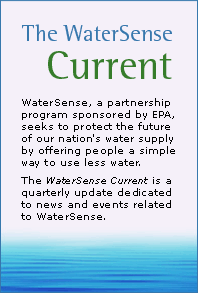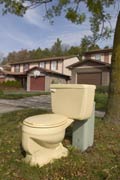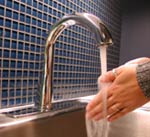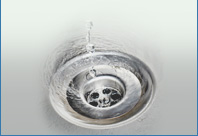The WaterSense Current Spring 2007
In This Issue II, Spring 2007:
 |
In This Issue: |
What's a Mile High and Green All Over?
An inside look at the water-saving features at EPA's Denver headquarters

One building in Denver, Colorado, is rising above the rest in terms of water efficiency and savings—EPA's newly constructed Region 8 headquarters. This building is projected to save more than 1 million gallons of water per year using innovative, commercial water-efficient technologies. Expecting to earn the U.S. Green Building Council's Leadership in Energy and Environmental Design (LEED®) Gold certification, this building will save more than 40 percent of the water typically used in a comparable, conventional building.
EPA installed high-efficiency plumbing fixtures, including aerators and auto-closing faucets. Lavatory sinks run at 0.5 gallon per minute, while the showers tout a 1.8 gallon per minute flow. Waterless urinals in the men's restrooms and dual-flush toilets in both the men's and women's restrooms reduce water use by 36 percent. Dedicated officials even made an administrative modification to the plumbing code to allow the technology for the waterless urinals.
To maximize savings outside the building, designers created a low-maintenance landscape using sustainable and native species. To top it all off, the building's roof is covered with 19,000 square feet of drought-resistant plants that require no irrigation and decrease stormwater runoff by nearly 30 percent. The reduction in stormwater runoff will minimize the impacts of water pollution on the South Platte River and minimize the pressure on the city's sewer system. The new headquarters' "green roof" is the first of its kind in Denver.
Learn more about Region 8's water programs.
It's Time: Why to Insist on WaterSense Irrigation Partners

Tired of trying to figure out how long to water your lawn during a hot summer or how to fix that leaky sprinkler head that sabotages your water bill? Get rid of the guesswork by hiring an irrigation professional who is a WaterSense partner. These experts have completed a WaterSense labeled certification program that instructs irrigation professionals in water-efficient techniques and practices, so you can worry (and water) less!
Why should you hire a WaterSense irrigation partner?
- Quality: All of our irrigation professional partners are certified by WaterSense labeled programs that teach the best in water-efficient irrigation.
- Commitment: By signing up as WaterSense partners, these professionals have committed to supporting water-efficient landscaping techniques and staying up-to-date on the latest practices and technologies.
- Peace of mind: You can rest assured that WaterSense irrigation partners are proficient in a variety of water-efficient techniques that will save you water, time, and money while reducing stress on your water system and maintaining a beautiful landscape.
What skills do WaterSense irrigation partners offer?
- Irrigation system designers know how to tailor irrigation systems to the surrounding landscape and local climate conditions.
- Installation and maintenance specialists have learned how to select equipment, site layout, and proper scheduling for optimal system performance.
- Irrigation auditors can identify systems that are distributing water unequally or inefficiently and determine how to improve performance.
WaterSense irrigation partners can talk with you about the best way to design, install, and maintain your landscape irrigation system. Find a WaterSense irrigation partner in your area. If none work near you yet, please check back soon; new irrigation partners are joining WaterSense every week.
Where Old Toilets Go...

If a new, water-efficient toilet sounds appealing, but you worry that throwing away your old—but functional—toilet is wasteful, you might be surprised to learn replacing an old, wasteful toilet is actually the smart thing to do. An old toilet could be wasting 4,000 gallons of water per year in your bathroom, when it could be doing something much more useful than flushing away all that water.
Toilet recycling programs across the country are turning old toilets into crushed porcelain for a variety of purposes. Glass or concrete crushers at recycling facilities can process ceramic toilets into finely crushed pebbles or a slightly larger aggregate. Pebbles can be added into asphalt for paving roads, and aggregate can be used for drainage projects.
Crushed porcelain not only keeps discarded toilets out of landfills and closes the recycling loop, but it also reduces the need to mine gravel, saving money and benefiting the environment. In fact, when Toronto, Ontario, used crushed toilets in landfill trenches, the city saved $8,732 by avoiding the purchase of gravel at $13.59 per metric ton.
How else are old toilets used? Here are just a few examples:
- Building Foundations - California's Inland Empire Utilities Agency used crushed toilets in its building foundation, which helped earn a Platinum certification from the U.S. Green Building Council's Leadership in Energy and Environmental Design (LEED®) program.
- Trail Pavement - San Antonio's Calaveras Park Nature Trail is paved with the remains of 1,000 crushed porcelain toilets. In Kitchener, Ontario, the walkway through the water-wise Greenbrook Demonstration Gardens is also paved in part with crushed toilets. Reportedly, the crushed porcelain even makes trails easier to see in the dark.
- Mulch - Crushed toilets are used as mulch in the San Antonio Botanical Gardens' Water Saver Lane Exhibit.
- Artificial Reefs - In Virginia, the Chesapeake Bay Foundation is working with the City of Hampton and Waste Management Corporation to build an artificial oyster reef to buttress declining oyster stocks. More than 100 cubic yards of broken porcelain from toilets has been collected for the reefs.
To find out if toilet recycling is available in your community, contact your state's municipal solid waste program.
Miami-Dade Toilet Replacement Program Just in Time for Dry Spell

For all its associations with lush tropical vegetation, pristine beaches,
and swampy habitats, coastal and southern Florida are often short
on fresh water. The west coast of Florida is under year-round water
conservation measures, and now water shortages are affecting the
southeast of the state as well. It has been so dry
in southeast Florida![]() that in March, the South Florida Water Management District imposed
mandatory water restrictions that are having an impact on more than
5 million Floridians, nearly a third of the state's population.
Miami-Dade is among the four counties affected, as well as Broward,
Monroe, and Palm Beach Counties.
that in March, the South Florida Water Management District imposed
mandatory water restrictions that are having an impact on more than
5 million Floridians, nearly a third of the state's population.
Miami-Dade is among the four counties affected, as well as Broward,
Monroe, and Palm Beach Counties.
These water restrictions have arrived just as WaterSense partner Miami-Dade Water and Sewer Department (MDWSD) is launching a new toilet replacement program, lending greater urgency to a program that has been in the works since last April. MDWSD will stage its first distribution of free high-efficiency toilets (HETs) to county residents in May 2007. Residents will simply need to arrive at the event location to pick up their new HET. For qualifying senior citizens and low-income households, MDWSD is also sponsoring a total bathroom retrofit, which includes installing new, water-efficient toilets, faucets, and showerheads.
The toilet replacement program also offers up to a $100 rebate toward purchasing an HET for Miami-Dade residents who cannot attend one of the free HET distributions or who would like to replace more than one toilet. The rebate program, which starts this month, is limited to two toilets per household and the existing toilets must have been installed before January 1, 1996.
By encouraging residents to retrofit their bathrooms with water-efficient toilets, MDWSD is helping to bring southeast Florida closer to its recent goal to cut water consumption by 15 percent and more in some areas. MDWSD will document water savings from the toilet replacement program by tracking participating household's water bills.
The good news for consumers is that even without access to free HETs, they are still a good deal. Many utilities offer rebates (contact your local water utility or WaterSense at (866) WTR-SENS (987-7367) to see if they are offered in your area) and these water-efficient toilets might help you save on your water bill. HETs are designed to use an average of 20 percent less water than standard 1.6 gallon per flush toilets, while maintaining or improving flushing power. As WaterSense labeled HETs hit the market in 2007, consumers can trust that this label ensures both high performance and water efficiency.
Learn
more about Miami-Dade's toilet replacement program![]() .
.
Partner Profile: VitrA USA
VitrA USA is the first manufacturer to partner with WaterSense, joining the program in January 2007. Located in Suwanee, Georgia, just outside Atlanta, VitrA USA is an international company, whose plumbing fixtures and bathroom products appear in more than 75 countries on five continents. Already a manufacturer of a variety of water-saving products, VitrA is very enthusiastic about being a WaterSense partner.
"The water shortages that are looming on the horizon for much of the USA have impressed upon us the urgency of being proactive in the fight to protect the environment," said Mert Karasu, technical manager for VitrA USA. "VitrA has a long-standing commitment to producing products that promote healthy-based living, and we are committed to developing even more products that serve to protect our natural resources."
To educate customers and sales staff, VitrA USA holds monthly training sessions and displays working models at their headquarters in Suwanee. Customers can flush the toilets and familiarize themselves with the water-saving technologies associated with the latest generation of high-efficiency toilets.
Please join EPA in welcoming VitrA
USA![]() to WaterSense.
to WaterSense.
WaterSense Specification for Faucets Drafted



Faucets account for more than 15 percent of indoor household water use—more than 1 trillion gallons of water in the United States each year. Even though federal law requires that new faucets not exceed 2.2 gallons per minute (gpm), older faucets can flow at rates as high as 3 to 7 gpm. To compound the problem, few people know the flow rate of their bathroom faucets.
To help consumers identify more efficient, high-performing bathroom faucets, WaterSense is developing the specifications or technical criteria for flow rate and performance that, once final, will lead to the WaterSense label appearing on faucets and faucet accessories.
WaterSense released the draft specification for bathroom sink faucets in February 2007. Public comments on the draft specification were originally due on March 23, 2007, but EPA has extended the comment period to May 7, 2007.
If every household in the United States installed WaterSense labeled bathroom sink faucets or faucet accessories, the country could save more than 60 billion gallons of water annually—enough to meet public water demand in Miami for five months! To learn more about how to reduce water use in the home, check out the WaterSense fact sheet on bathroom sink faucets.
Save on Your Electric Bill Too!
Ever think about how much energy it takes to get water from the utility to your faucet, then down the drain to the sewer? Most people do not realize that American public water supply and treatment facilities consume about 50 billion kilowatt-hours per year, which is enough electricity to power more than 4.5 million homes for an entire year.
Installing WaterSense labeled plumbing fixtures can help Americans save not just water, but energy too. By using about 20 percent less water to provide the same plumbing performance, WaterSense labeled products require less energy to deliver the water to your home and, more importantly for your checkbook, less energy to heat it too.




